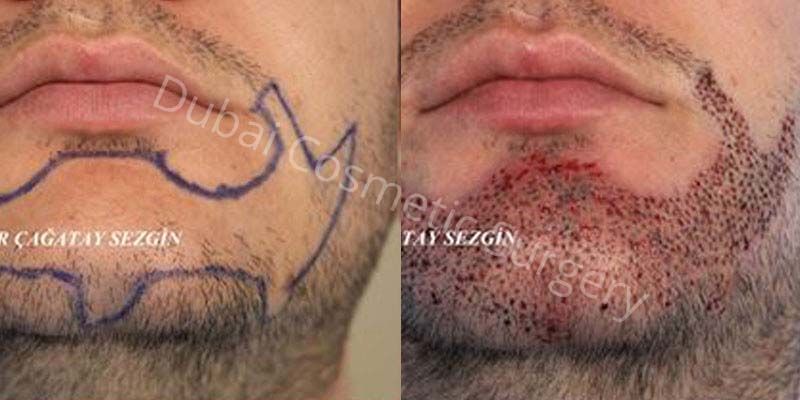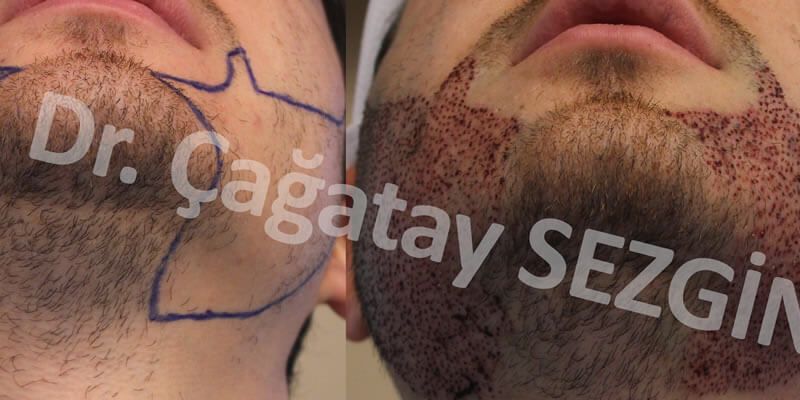Beard hair transplant in Dubai is the most effective surgical procedure that can help you create a full and perfectly sculpted beard by increasing the density and fullness of a sparse or patchy beard. Undergoing beard hair transplant surgery can completely change your facial look, providing a sharp, full, and carefully trimmed beard.
Table of Contents
Before & After Results
The outcomes of beard hair transplant in Dubai will become visible over 12 to 18 months and once transplanted hair follicles begin to grow, they will continue to grow for a lifetime. You can shave and groom the transplanted hair just like other facial hairs. No Guarantee, as the results may vary from person to person.





Beard Transplant Candidate
A Beard hair transplant procedure may be an ideal option if you:
- Are unable to grow a beard.
- Have a spotty or patchy beard and you want to enhance its density and fullness.
- Lost the desired density and appearance of your facial hair due to scars or burns and you want to conceal problematic areas.
- Want to modify the pattern and shape of your beard.
- Wish to enhance the appearance of your facial features by enhancing your beard.
Beard Transplant Goals
Beard hair transplant Dubai aims at:
- Restoring the thickness and density of congenital sparse or patchy beard caused by some trauma or disease.
- Enhancing the aesthetic appearance of your beard by increasing its density and enhancing its shape.
- Helping you improve your facial aesthetic appearance, providing a more masculine and mature look.
Beard Transplant Techniques
The latest beard hair transplant surgery can be performed using the following two techniques:
- Follicular Unit Transplant (FUT) or strip method: This technique involves harvesting a strip of the scalp at the rear and then creating hundreds of tiny grafts to be implanted in the bald facial area.
- FUE Follicular Unit Extraction: This technique involves the extraction of individual follicular units using a tiny punch tool.
Pre-op Preparation
Just like a hair transplant, the beard transplant in Dubai also requires following some important pre-op instructions. Listed below are some common instructions that nearly every patient needs to follow:
- Consult your doctor before stopping any medications, including anti-inflammatory drugs, aspirin, and other blood-thinners..
- Avoid drinking caffeinated drinks on the day of the surgery.
Beard Transplant Procedure
The duration of beard hair transplant surgery can vary, but it typically takes 4 to 8 hours, depending on the number of grafts required. The steps involved in the surgery are:
- Preparation of donor area: Firstly, the surgeon prepares the donor area by trimming hair to make follicular extraction easy. The area is cleaned as well.
- Administration of anesthesia: Then local anesthesia is administered in the donor area to numb it and make the procedure painless.
- Extraction of hair follicles: After the administration of anesthesia, hair follicles are extracted using either the FUE technique or FUT technique depending on the number of hair required.
- Preparing grafts for implantation: Then hair follicles of the desired size are prepared from extracted grafts under a powerful microscope.
- Preparing recipient area: While hair follicles are prepared for implantation, the recipient area – beard – is prepared by administering local anesthesia. Also, tiny incisions are made with a small semi-circular instrument.
- Implantation of hair follicles: Finally, the surgeon carefully implants hair follicles keeping in mind the desired density, thickness, and pattern of the beard.
Post-op Care
Some common beard hair transplant post-op instructions that you may need to follow include:
- Keep the transplanted beard area dry.
- Avoid shaving for at least 10 to 14 days after surgery.
- Avoid massaging the transplanted area for the time period recommended by your surgeon, which is typically around 10 days.
Beard Hair Transplant Cost
Beard Hair transplant cost in Dubai varies from person to person because it is calculated by determining various factors which include;
- The technique used: FUE or FUT
- Number of grafts: It varies from person to person but the average price per graft starts from AED 10 – AED 20
- The Quality of facility: Service quality is the main factor that determines the cost.
Hair Transplant Surgeon
Procedure Recovery
The Beard hair transplant procedure typically involves minimal pain and a smooth recovery period, but individual experiences may vary. However, recovery may vary from one patient to another depending on several factors like the technique used.
- Most of the patients are able to resume their normal routine 2 days after surgery.
- For the first few days after beard hair transplant, crusts or scabs will appear around the transplanted hair. They will fall off in about 10 days.
Free Consultation
If you want to have a fuller beard, a beard hair transplant is the right option for you. Fill in the consultation form to discuss the procedure with one of our experts in detail. Dubai Cosmetic Surgery Clinic offers a free personalized consultation to all of its new and existing patients. So, fill in the form given below and book your appointment.
Fill in the form to get a consultation
100% Financing with 0% Interest

